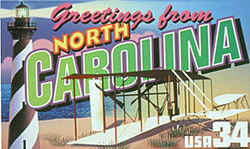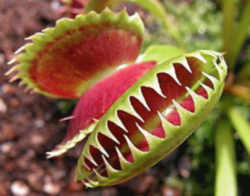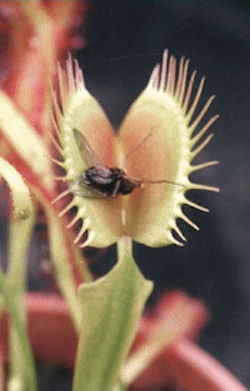
North Carolina Symbols
North Carolina State Carnivorous Plant
Venus Flytrap

(Dionaea muscipula)
Adopted in 2005.
The General Assembly of 2005 adopted the Venus Flytrap, (Dionaea muscipula,) as the official State Carnivorous Plant (Session Laws, 2005, c. 74) .
The Venus Flytrap is currently listed as a Species of Special Concern, which means, "...any species of plant in North Carolina which requires monitoring
but which may be collected and sold under regulations adopted under the provisions of this Article" (NCGS 106-202.12).
North Carolina State Carnivorous
Plant:
Venus Flytrap

The Venus flytrap (also Venus's flytrap
or Venus' flytrap), Dionaea muscipula, is a carnivorous plant native to subtropical wetlands on the East Coast of the United States. It catches
its prey- chiefly insects and arachnids- with a trapping structure formed by the terminal portion of each of the plant's leaves and is triggered by
tiny hairs on their inner surfaces. When an insect or spider crawling along the leaves contacts a hair, the trap closes if a different hair is contacted
within twenty seconds of the first strike. The requirement of redundant triggering in this mechanism serves as a safeguard against a waste of energy
in trapping objects with no nutritional value.
Dionaea is a monotypic genus closely related to the waterwheel plant and sundews, all of which belong to the family Droseraceae.
Though it is known and cultivated throughout the world, it is native only to a small area of the Coastal Plain in North and South Carolina (mostly
within a 75 mile radius around Wilmington).
The trap is activated when an insect (or other object) brushes 2 or more times against bristles that grow on the surface of the leaf. The trap springs
shut in less than a second, but doesn't close completely until it has determined (either chemically or through movement) if it has caught worthwhile
food. If it has, the trap gradually seals completely shut, allowing digestion to take place. It reopens in 3 days to 2 weeks.
Venus Fly Traps are quite easy to grow, as long as they are given the proper conditions.
They should be grown in very bright light, but not in direct, hot sun. A warm, humid environment, with a constant supply of moisture, such as you would find in a terrarium is ideal.
The potting mixture should consist of a mix of 70% peat or sphagnum moss and 30% perlite or coarse pumis.
These plants are sensitive to chemicals, so you should only use distilled water or rain water. If it is absolutely necessary to use tap water, allow it to set for 24-48 hours in an open container, to allow the chlorine and other chemicals to dissipate.
Fly Traps do not need fertilizer, the insects which they consume provide them with all the nutrients they need.
Venus Fly Traps have an active growing and feeding season, from May through October. During this period the soil should be kept constantly damp. Temperatures should be kept between 70 and 95 degrees F.
During the winter, they require a dormant period of about three months. At this time, much (if not all), of the foliage will die back. The entire planter may be moved to an area where the temperature will remain at 45-50 degrees F., or the bulb may be removed, sprayed with fungicide, wrapped in damp, live sphagnum moss, placed in a plastic bag, and moved to a cool area.
North Carolina Senate Bill 116 - 2005
GENERAL ASSEMBLY OF NORTH CAROLINA
SESSION 2005
S 1
SENATE BILL 116
Short Title: Venus Flytrap Official Carnivorous Plant.
(Public)
Sponsors:
Senator Purcell.
Referred to:
Rules and Operations of the Senate.
February 14, 2005
A BILL TO BE ENTITLED
AN ACT to adopt the venus flytrap as the official carnivorous plant of the state of north carolina.
Whereas, the Venus flytrap is a small flowering perennial plant that grows in boggy areas of the Southeastern United States; and
Whereas, the Venus flytrap is unique in that it is a carnivorous plant characterized by leaves with hinged lobes that spring shut when stimulated by
insects; and
Whereas, the Venus flytrap is native to the coastal plain of North Carolina and is legally protected by the State as a species of special concern;
and
Whereas, the Venus flytrap deserves to be adopted as the official carnivorous plant of the State of North Carolina because it is a mysterious and wonderful
natural resource; Now, therefore,
The General Assembly of North Carolina enacts:
SECTION 1. Chapter 145 of the General Statutes is amended by adding a new section to read:
"§ 145-22. State carnivorous plant.
The Venus flytrap (Dionaea muscipula) is adopted as the official carnivorous plant of the State of North Carolina."
SECTION 2. This act is effective when it becomes law.
Taxonomic Hierarchy: Venus Flytrap
Kingdom: Plantae - Plants
Subkingdom: Tracheobionta - Vascular plants
Superdivision: Spermatophyta - Seed plants
Division: Magnoliophyta - Flowering plants
Class: Magnoliopsida - Dicotyledons
Subclass: Dilleniidae
Order: Nepenthales
Family: Droseraceae - Sundew family
Genus: Dionaea Ellis - Venus flytrap
Species: Dionaea muscipula Ellis - Venus flytrap







